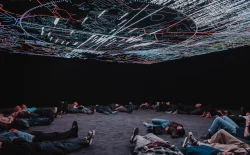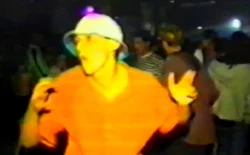The thing about the future is that once it’s here, it feels rather mundane.
In the 1980s and 1990s, dance music captured a feeling of forward motion that has now flattened out and decelerated to a present where everything is (almost) always available, everywhere.
When jungle bubbled up from a night-time stew of house, techno, and breakbeat circa 1992, it brought with it an energy unlike any before. A few years later, jungle was refined into drum & bass and the possibilities seemed endless. At its early peak, the music felt more futuristic than any other electronic genre. But then the future crash-landed into the present. Unable to sustain its forward motion and torn apart by an inner ideological conflict between underground roots and commercial potential that has defined it since, drum & bass locked itself up. Despite being a global phenomenon, friendly with the pop world and healthy on the ground, over the past 15 years drum & bass has become a sort of black sheep in the dance music family — too hard for the uninitiated while converts seem content with the smug satisfaction of ‘getting it.’
At the tail end of 2014, I interviewed Manchester producer Dub Phizix, an artist bred on the music’s golden years who emerged in the early 2010s with the dancehall-inflected single ‘Marka’. Discussing the historical pedigree of drum & bass, he kept returning to the idea that it had always been “an innovator’s music.” Therein lies the crux of the music’s dilemma: it’s an innovative genre — technical, versatile, forward-thinking — that remains wed to antiquated ideas of underground realism. And yet, it is this attachment to ‘not giving a fuck’ that gave us innovators like Photek, Roni Size, 4Hero, and Goldie in the 1990s. And it’s why the fringes of the music have always incubated exciting ideas, even after everyone decided to look elsewhere.
“Maybe drum & bass has nothing to prove.”Amit
Amit Kamboj has been writing drum & bass since the early 2000s. The story of Kamboj’s career to date is typical of drum & bass’s fringe innovators: lauded by those enamoured with the music’s visionary potentials but too ahead of the curve to reap all the benefits. “It’s interesting that most who experiment within drum & bass are always critically rewarded,” he says. “However, it can take time for experiments to gain mainstream acceptance.” Early on, Kamboj honed in on the music’s half-time potentials, playing with the tension inherent in working at a 170BPM. The results left people “feeling confused as to what category the music belonged to,” he recalls. Today, things are easier: “That style is now accepted as another branch of the music. When I play my old material, tracks like ‘Immortal’ or ‘Swastika’, to new crowds, the response is completely different.”
In 2013, after 10 years of working with other labels, Kamboj set up his own AMAR recordings. In February this year, he released the 4 Stories EP which included ‘Survivor’, a slower production he says “resonated with listeners from a variety of backgrounds.” Most recently, he began working on a score for Gloria, a film about a young female offender trying to get her life back on track. It’s a fitting move for a producer whose music has always a cinematic quality. “Film work has been an influence from early on,” Kamboj admits. “Whatever I write tends to be for an [imagined] narrative of sorts. I find myself looking for the perfect beat, mood and texture that can work on a sound system and a screen.”
As with any genre of music, innovation and variety in drum & bass are strongest when approached with a singular vision. In that regard, Exit Records, now in its thirteenth year, remains a leading light. Under the guiding hand of dBridge, himself an early risk taker, it has remained a steady, driving force. In the summer of 2014, dBridge launched Pleasure District, an Exit sub-label focused around the Heartdrive podcast series he had begun the year before with longterm partner Kid Drama. Heartdrive itself was a continuation of the Autonomic series and sound, created with Boddika in the late 2000s, which had been crucial in revitalising the experimental side of drum & bass at the time.
“It seemed like a natural progression for this music [Kid Drama and I] write together,” says dBridge of Pleasure District and Heartdrive. At the same time, Kid Drama set up CNVX this year, a sub label of his own Convex Industries, as another outlet for both drum & bass and experimental work, culminating in a genre-less album as Mikarma in the autumn that dealt with depression by channeling his love of the 1990s Warp catalogue. “I’m just a producer, not defined by genre,” he admits, “if anything it’s the gear I use that will define the type of music I make.”
Exit Records had a strong year in 2015, with a string of diverse albums by solo artists and anonymous collective configurations — Module Eight, Mark System, Joe Seven, Binary Collective — alongside dancefloor-minded EPs from both new talent and established artists. “I like it all and try to find space for it all,” dBridge says of the label’s diversity. “Maybe that comes across as a bit disjointed, but if it wasn’t, it would be really boring.” The key is that this range of approaches, styles, and ideas keeps him interested and motivated to do more, even after 20 years. He continues, “I’m 100% behind everything we’ve put out, the new artists we’ve brought through, and how they go on to make their own careers. I couldn’t be happier.”
“You don’t have to like everything.”Kasra
Another label that has staked its own corner of drum & bass is Kasra’s Critical Recordings. The past 24 months have been the label’s “busiest and most creatively fruitful,” he says. In 2015, Critical released two albums that stand in stark contrast: Enei’s Rituals, a hard-edged ride that plays to the music’s stereotypes, and Sam Binga’s Wasted Days, a mixtape-cum-album that could be the soundtrack to a future chain of strip clubs stretching from the Dirty South to Britain’s inner cities. This diversity of styles hasn’t fazed Critical fans, leading Kasra to feel like they trust the label’s choice. “You don’t have to like everything,” he admits.
Thanks to Kasra’s comfort with giving space to experiments on his label, Ivy Lab, the trio of drum & bass producers Stray, Halogenix, and Sabre, were able to pursue their own take on half-time over the past few years. In November, they released a debut album, 20/20 Volume 1, that blends drum & bass engineering and hip-hop head nod. Taking inspiration from artists both in and outside the scene — Alix Perez, Eprom, Machinedrum, Om Unit, Fracture — Ivy Lab found drum & bass fans and newcomers willing to join them. Their 20/20 club night, which has been running in London for the past two years, was a pilot for the idea. “We play beats, R&B, juke, footwork, the experimental end of drum & bass,” Sabre explains. “It’s a wide bracket with a common theme of the half-time spectrum.”
For Kasra, drum & bass crowds remain the strongest indicator of what type of show you’ll get, though that is changing. “In Eastern Europe people want it pretty full on and in your face but at Fabric, in London, we can be more experimental and I feel that has come from the crowds becoming more open.” dBridge recognises that there is a line for DJs in a scene where you “can’t be on some ‘I’m here to educate you’ thing. But I can do that at some point in the set, and I think at a lot of parties people know they’ll get these curveballs thrown at them while still being able to dance.”
“Stylistic convention is easier to talk about than emotion.”Sully
One of the key issues artists attached to drum & bass have faced is being tarnished by the music’s reputation, even when they’ve built a career of being versatile and uncompromising. “Genres tend to morph, tempos will speed up, and new names will appear,” says Kid Drama. “This music went from hardcore jungle to drum & bass and then got stuck with the name. When you say drum & bass people tend to think of the shit in the charts or the typical 2-step sound, but we never stopped writing new things, taking it to another place.” At the same time, the music seems to be benefiting from a disregard by younger generations towards established genre boundaries. It’s why a club night such as 20/20 can work and align itself with the likes of Low End Theory and Soulection: they’re all collectives united under a porous aesthetic of electronic music who, as dBridge points out, are “building a place for their sound to grow from.” Earlier this year, Kasra experienced a similar sense of broader acceptance in a very different place: at the Electric Daisy Carnival in Las Vegas, a staple of America’s current EDM infatuation. “It was incredible,” he remembers of his set there, “the crowd was responsive and respectful and we didn’t play anything we felt we should.”
The flip side to staking a claim in the murkier waters of a genre is that, sometimes, you’re lead away from it. After Geoff Wright, known as DJ Presha, founded Samurai Music in 2007 he opted to add sub labels to sidestep pigeonholing. Releasing music from both new (Indigo, Dub Phizix) and existing artists (Loxy, Calibre, Paradox), Wright took his biggest chance in 2011 with Samurai Horo, a home for experimental electronic music that sits in between ambient, drum & bass, and techno. Starting with 2013’s Scope compilation and followed by albums from Tokyo’s ENA – 2014’s Binaural, this year’s Divided – and ASC’s recent Imagine The Future, Horo has lived up to the innovative core of the music. “Watching the rise of people like ENA and having a lot of our favourite artists in the techno and experimental worlds get in touch has been great,” says Wright.
But while the experimentation has been embraced by outsiders, Wright still encounters resistance from fans. One of the “strange but true” experiences he’s had involved “people refusing to accept that a 128BPM record isn’t drum & bass.” Still, “for every misinformed negative review or comment, we pick up new fans from areas we’re trying to target.” Next year Wright is splitting the labels off, sectioning Horo away from drum & bass, as an acknowledgment that being diverse while attached to a scene can be hard. Horo’s relative success outside of drum & bass has also reinforced Wright’s own disillusionment with the music. “Outsiders to drum & bass need something interesting to make them have a look and dig,” he explains. “I’m not sure what that could be these days. I still love a lot of drum & bass but it’s nowhere near as diverse as techno. It’s become a genre that is repeating its past over and over. I think 2009 was a great year for it, but can’t we move past that?”
“d&b is in its third decade, it’s not going anywhere.”dBridge
Nostalgia is a problem affecting all strata of cultural creation and consumption today. But nostalgia is also how music finds a way to reinvigorate itself. The fact that jungle shared a common tempo and rhythmic intensity with Chicago’s footwork was the main reason the two genres came together in the early 2010s through the work of acts like Om Unit, Fracture, Machinedrum, and, ultimately, the late DJ Rashad and the Teklife crew. From sets by Zomby and Kode9 to Lee Gamble’s Diversions 1994–1996 and Special Request’s Soul Music albums, jungle has seen a resurgence of popularity that continues to feed experiments in and out of the scene.
Sully, a Norwich-based producer whose output has been moving through the various sides of the London’s dance music prism, has spent the past couple of years indulging his interest in the genre. “My first productions were slower but the elements of jungle I liked were always there,” he explains. “There’s nothing wrong with nostalgia, it’s as valid an idea to explore as the digital age or a painful breakup. I think heart is key though. Any kind of idolatry has to be done sincerely or it comes off as a bit thin and opportunistic.”
Flock, Sully’s most recent release for Astrophonica, a label helmed by Fracture, feels suspended in time, harking back to the glory days of breakbeats but still resonating with the here and now. One thing Sully noted, echoing previous comments from dance music luminaries such as Mark Pritchard, is the rhythmic freedom that comes with jungle’s tempo range of 160BPM. He admits to having “only scratched the surface of it,” while “other core concepts of music are as open at 160 as in any other tempo. I guess stylistic convention is easier to talk about than emotion so maybe we focus on that a little more than we should.”
Another artist who’s managed to tap into the twin axis of nostalgia and innovation is Machinedrum. After crafting an album that was part nostalgia, part discovery and part therapy, 2011’s Room(s) for Planet Mu, the American producer moved to UK institution Ninja Tune. There, he has continued to refine a synthesis of drum & bass, footwork, and hip-hop with 2013’s Vapor City. Machinedrum’s decision to return to some of his early musical infatuations with this new vision paid off: luminaries from the drum & bass and footwork communities have championed his work, which he calls “life affirming,” and he’s had ongoing touring commitments around the world.
Machinedrum’s embrace of the tempo and stylistic tropes of drum & bass is interesting in how it has brought him success outside of the scene itself, proving that the music can exist in artistic spheres other than a saccharine pop mainstream or holier-than-thou underground. He quotes the innovation of artists like dBridge, Amit, Fracture, and Rockwell as responsible for showing him a way forward because “they kept taking risks and pushed the music past these self-imposed limitations into new realms that were both retro and modern in a fresh and interesting way.”
Unattached to the drum & bass scene, an artist like Machinedrum also shows how the music’s tempo, often its Achilles heel, is becoming less of an issue. “I’ve seen a wider acceptance of faster BPM at parties,” he says. “In the past I would get heckled a lot, especially in America, for playing anything above 140BPM. Electronic music in general is more understood and accepted now and people search for sounds different to what is popular.”
“I’ve seen a wider acceptance of faster BPM at parties.”Machinedrum
In the process of writing this feature I began to wonder why drum & bass had had a harder time proving itself to the mainstream than house and techno, genres that both preceded it and influenced its creation. Machinedrum points to dance music’s roots in disco as one reason why there might be a schism between those worlds. “I think it’s closer to hip-hop than house or even dance music in general,” he says. It’s an idea echoed by the Ivy Lab trio. “Most of the people you end up meeting come into drum & bass through metal or hip-hop,” says Stray. This close bond between drum & bass and hip-hop has always been apparent on the US West Coast. It’s not by chance that Daddy Kev, Low End Theory’s co-founder, used to run the Los Angeles chapter of the seminal Konkrete Jungle parties 15 years ago, or that rap luminaries from the Good Life Cafe scene could be found MCing at the shows. There is a symbiotic relationship between drum & bass and hip-hop that is ongoing, heightened in the experimental fringes of both genres where it feeds innovation.
“[Drum & bass] still feels like the bastard child of dance music. The underground side never gets the respect it deserves and probably hasn’t since the Blue Note days,” says Kasra, in reference to the late 1990s London residency that enshrined Goldie’s Metalheadz label into the history books. “Maybe drum & bass has nothing to prove,” argues Kamboj before pointing to the timeless influence of King Tubby and dub music as a more valid comparison, one that certainly holds weight. “The fact drum & bass is in its third decade shows it’s not going anywhere,” dBridge summarises. “It’s big enough that pop acts are choosing it as a career choice while still underground enough for experiments. For a long time drum & bass borrowed from other genres but I think today you can see roles reversing, it’s influencing genres like house and techno. It’s an integral part of dance music as a whole. It’s where it deserves to be.”
Trying to ascertain why drum & bass isn’t upheld in the same light as house and techno makes for good think-piece fodder but it’s the wrong question to ask. It’s not even a question that should be asked. Drum & bass may not be the most popular kid on the dance music block but it remains the most technical and daring, a true futurist. And at the end of the day, to quote Sully: “It’s still the bollocks.”
To accompany this feature, Laurent Fintoni selected 20 essential drum & bass releases from 2015 including albums, tracks, and EPs from around the world. Stream it below via YouTube.













![180 Studios presents new Ryoji Ikeda installation, data-cosm [n°1]](https://factmag-images.s3.amazonaws.com/wp-content/uploads/2025/10/ryoji-ikeda-data-cosm-1-250x155.webp)









